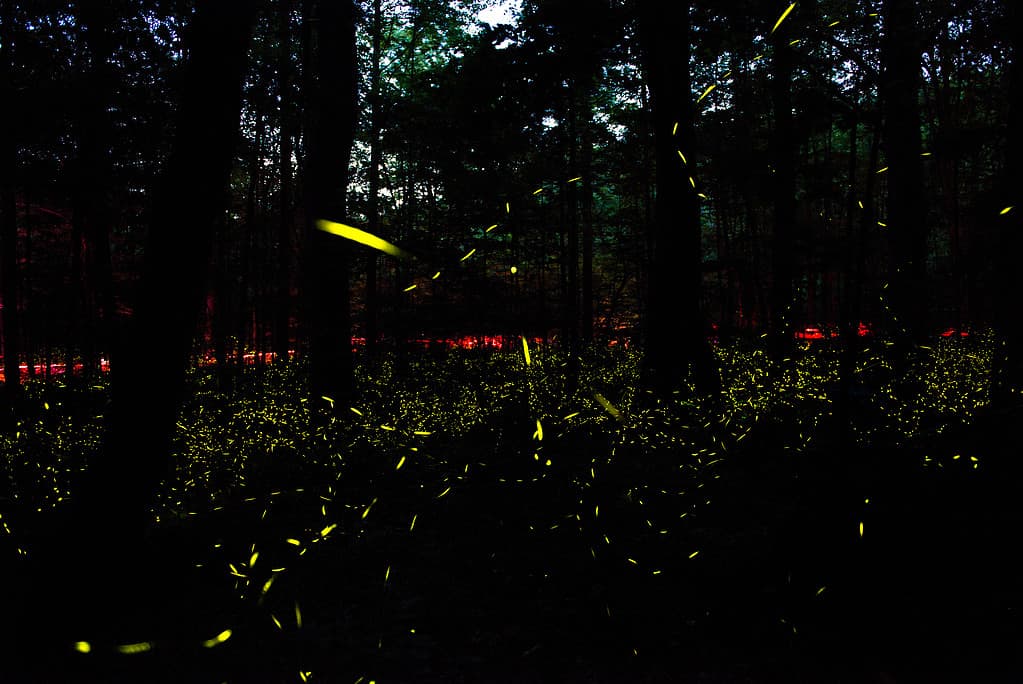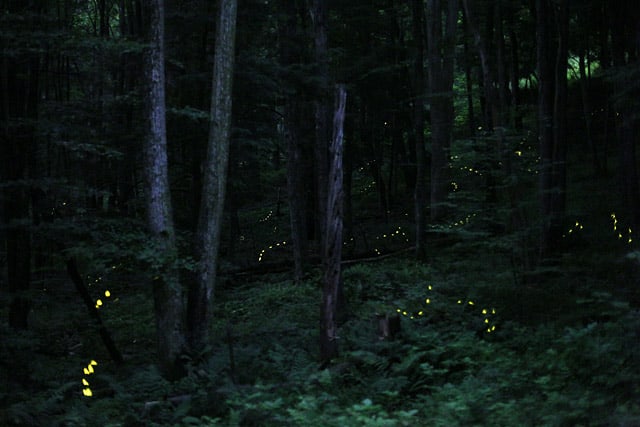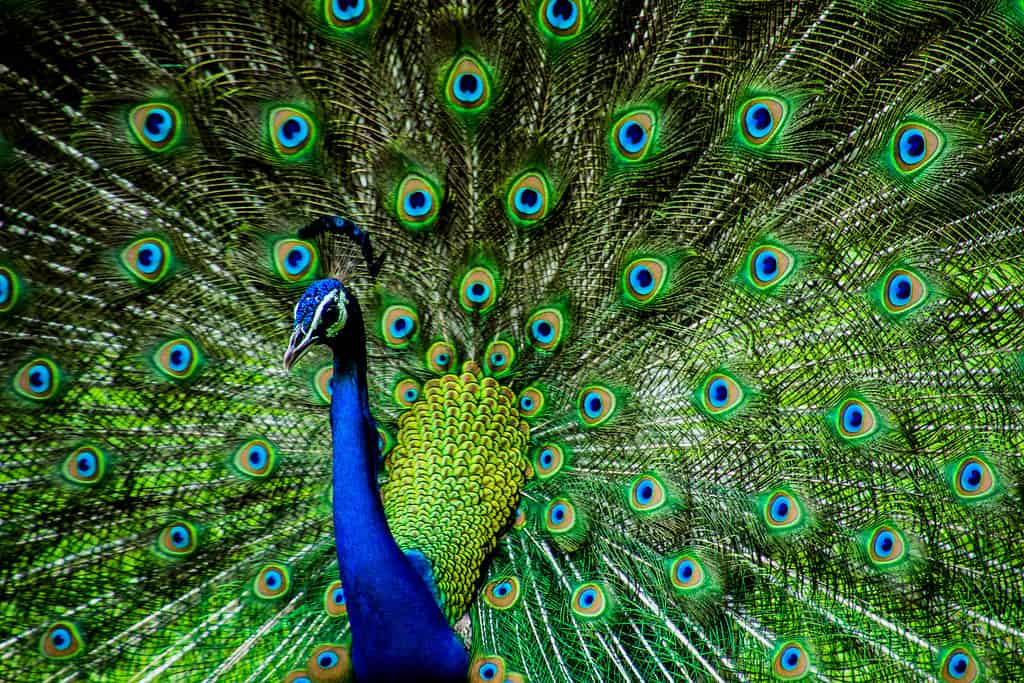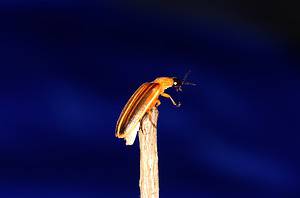Fireflies are a natural wonder. These beetles feature organs under their abdomens that light up through a chemical reaction that combines oxygen with a chemical called luciferin. This bioluminescence creates wonder in children and adults alike, especially when these “lightning bugs” sync their flashes together. Out of the more than 2,000 firefly species on Earth, only about a dozen coordinate their illumination. These synchronous fireflies create an annual spectacle that has become a bucket-list experience for many nature lovers. Here’s a look at three places where you can witness the phenomenon for yourself.
Great Smoky Mountains National Park
Great Smoky Mountains National Park (GSMNP) is the most visited national park in the United States. It is also the most visited place in the U.S. to witness synchronous fireflies. You can see these bioluminescent insects near the Elkmont Campground in GSMNP.
Of the 19 firefly species in the park, only one is synchronous: Photinus carolinus. In the video below, Becky Nichols, an entomologist at GSMNP, further explores the biology and synchronicity of these fireflies.
These synchronous fireflies put on an unrivaled display, but for most of the national park’s history, the phenomenon wasn’t all that well-known among the general public. The advent of social media changed everything. As they were playing Farmville and “poking” each other in the early days of social media, users were also watching videos of GSMNP’s synchronous fireflies. This natural spectacle was a secret no longer, and visitors began to arrive by the thousands to witness it for themselves.
Due to the overwhelming number of visitors hoping to see the early-June display of the park’s synchronous fireflies, the National Park Service had to institute a lottery system. When entering the lottery drawing, applicants can select both a preferred and alternate date when they can travel to the park to view the fireflies. There is a one-dollar fee to enter the drawing.
Winners will be charged an additional $24 to cover supplies and personnel costs. Attendees will park at the Sugarlands Visitor Center and ride a trolley to the viewing area near the Elkmont Campground.
The 2023 lottery opened on April 28. It closes on May 1. The synchronous firefly viewing event runs from June 4-11.

Synchronous fireflies in the Great Smoky Mountains National Park are a wonder to behold!
©iStock.com/QEYES
Congaree National Park
While GSMNP is the most well-known, it is not the only national park to feature synchronous fireflies. Congaree National Park in South Carolina is a wonderful place to view a different species of these syncing bioluminescent beetles: Photuris frontalis, commonly known as Snappy Syncs.
Like GSMNP, Congaree has also instituted a lottery system to view the park’s synchronous fireflies. The lottery is open in early April.
Parts of the park are closed during the firefly synchronization period. Some of these areas include Cedar Creek between Bannister Bridge and South Cedar Creek Canoe Launch, as well as Longleaf and Bluff Campgrounds. Along with the closure of these front-country campgrounds, no backcountry camping permits are issued during the synchronization period.
The firefly viewing area is located adjacent to the Harry Hampton Visitor Center. The synchronous firefly display at the national park lasts for two weeks in late May and early June.

Congaree National Park plays host to “Snappy Sync” fireflies each May/June.
©iStock.com/kellyvandellen
Allegheny National Forest
The Allegheny National Forest (ANF) is another spectacular location for seeing synchronous fireflies. The species found here is the same one found in GSMNP: Photinus carolinus. The synchronous fireflies in ANF are a recent discovery. A group of campers in 2011 noticed fireflies that seemed to flash in unison near their campsite. They contacted a research team who traveled to Kellettville to study the phenomenon the following year. This marked the first time that synchronous fireflies were officially documented within ANF.
The popularity of these fireflies led to the creation of the Pennsylvania Firefly Festival which is held every June. It comes complete with yet another lottery for firefly viewing. The 2023 lottery is closed.

These synchronous fireflies were photographed in Pennsylvania just a few years after the species was discovered in ANF.
©Firefly Photos by Radim Schreiber; FireflyExperience.org / CC BY-SA 3.0 – License
Studying This Synchronicity
The synchronization of these fireflies has been long studied and debated. At one time, many researchers claimed it wasn’t actual synchronization. Rather, they posited that it was merely the illusion of synchronization that was caused by, among other things, the blinking of the human eye.
Since then, researchers have captured the phenomenon on video. A frame-by-frame analysis reveals there is true synchronization among these fireflies. But it is not an “all on, all off” synchronization, like flipping a light switch. Studies of Photinus carolinus in GSMNP reveal that synchronization moves like a wave. A burst of flashes begins in one place and then cascades through the forest at around a foot and a half per second.
We still do not know much about the synchronization event that occurs every year in early summer. One thing is certain, though. The wonder of these synchronous fireflies has captured the imaginations of everyone who has witnessed it.

There is still much to learn about the
Photinus carolinusfirefly.
©National Park Service / Public domain – License
Why Synchronize?
The synchronization of the Photinus carolinus and Photuris frontalis fireflies has both fascinated and confounded researchers. It is widely believed that synchronization is tied to mating, but that also raises questions. This would seem to be at odds with how much of the rest of the natural world functions.
Many animals have mating seasons and rituals where the males do their best to stand out from the herd, flock, or whatever other name the group of animals may have.
For example, the males of many species fight one another for dominance and mating rights. Think of bull elk battling one another during the rut, for example. These bulls spar to set themselves apart as the best mating option for the cows. Elk are far from the only species to fight for mating privileges, though. Male lions, gorillas, kangaroos, and many other animals all fight over who gets to mate with nearby females.
Also, consider the peacock’s ostentatious display to win the affection of a peahen. The peacock spreads his feathers and shakes them to create a rattling sound and an iridescent visual display to catch the eye of a peahen.
There are even elaborate mating rituals in the insect world. Male jumping spiders, for example, dance to attract the attention of females. But the dance had better be a good one. If the female is unimpressed, she may attack, kill, and eat the male!
The consistent point of all of these examples is that the males across much of the animal kingdom do everything possible to stand out, appear dominant, or otherwise show themselves to be the unique and best choice for a female’s mate.

The peacock goes to great lengths to catch the attention of a peahen.
©Kandarp/Shutterstock.com
A Basic Question
The very existence of synchronicity among these few firefly species raises a basic evolutionary question: How does blending in help any individual male stand out to a potential mate?
This question has not been fully answered yet, but researchers may be piecing the puzzle together. Scientists have found that female Photinus carolinus fireflies are more likely to respond to males who are fully synchronized but would not respond to males who are out of sync. This could be a means of species recognition between males and females in the visually cluttered environment of a forest. Simply put, it is possible that male Photinus carolinus fireflies stand out by blending in.
The wonderful mystery of this synchronization has captivated visitors to the locations discussed earlier. And it’s why thousands more will keep coming to witness it in the future.

The wonder of the synchronous fireflies will keep visitors coming back to Elkmont in the Great Smoky Mountains National Park every year.
©Great Smoky Mountains National Park from Gatlinburg, TN / Public domain – License
The photo featured at the top of this post is © iStock.com/QEYES
Thank you for reading! Have some feedback for us? Contact the AZ Animals editorial team.






